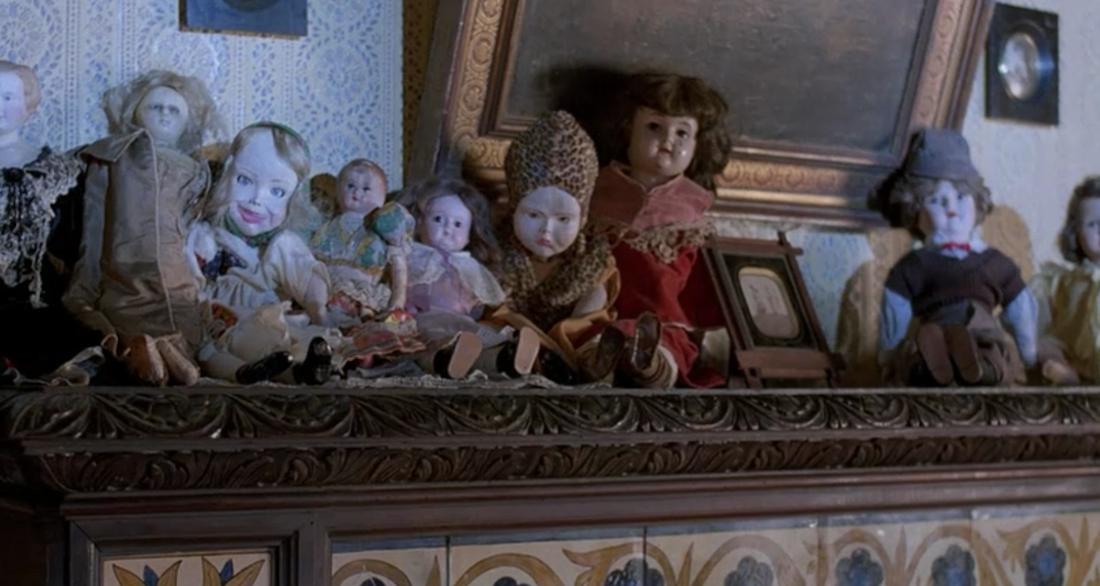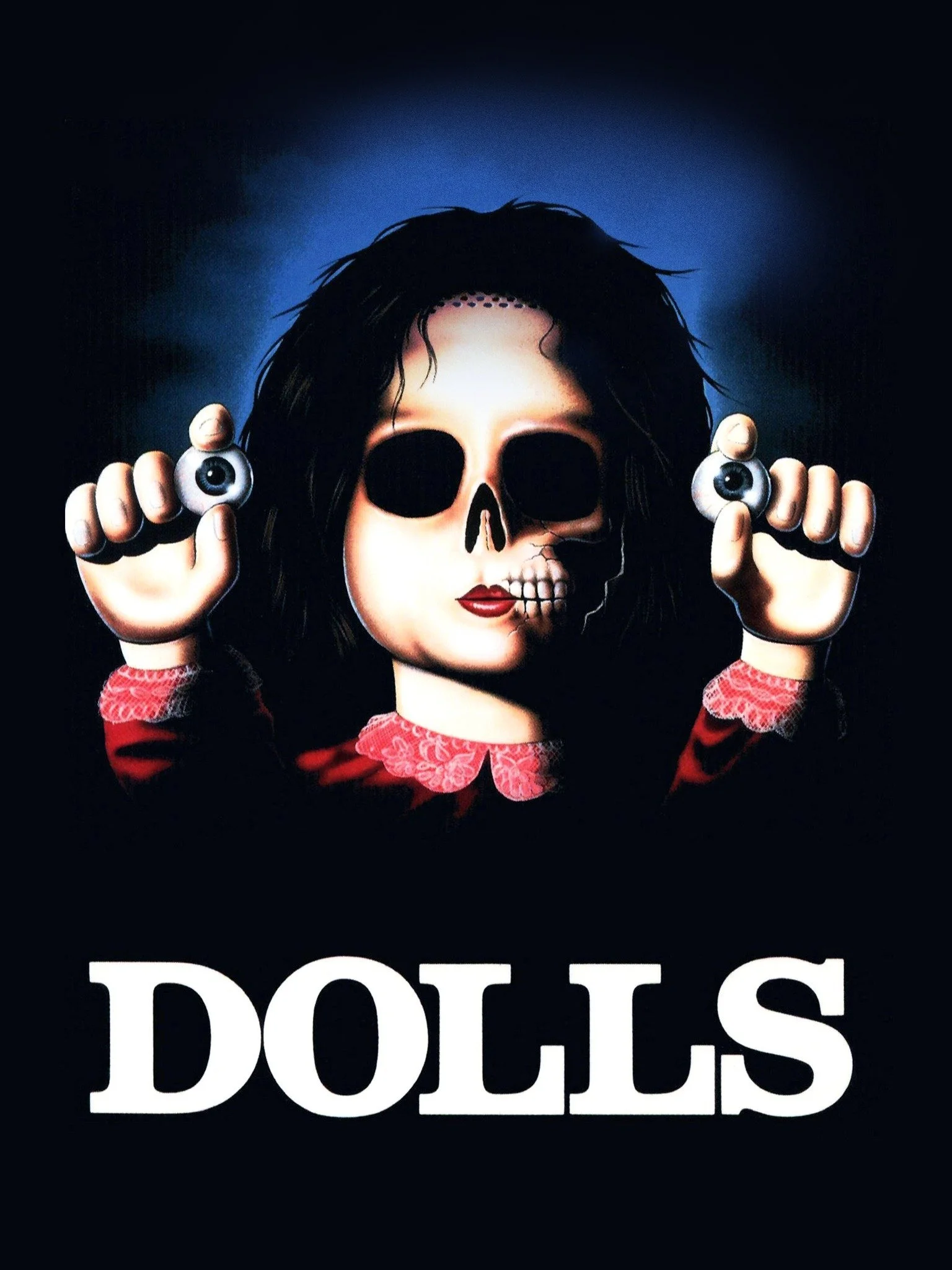DOLLS (1987)
For viewers only familiar with director Stuart Gordon’s gleefully transgressive Lovecraft and Poe adaptations, DOLLS must look like a strange anomaly in his career. To be certain, it’s an odd film that never achieves the subversive high of Gordon’s best work, but it marked his first attempt at reinventing his “brand” of filmmaking, lest he get pigeonholed as the director who only covers Jeffrey Combs and Barbara Crampton in blood and slime. If not for an ill-timed nosebleed (more on that later), DOLLS points in the direction Gordon’s career could have possibly gone very differently.
With DOLLS, Gordon wisely never tries to hide what he is attempting to pull off in a movie of constant tonal fluctuations. In the first scene, young Judy (Carrie Lorraine) is shown reading Hansel & Gretel in the backseat of a car as her selfish father David (Ian Patrick Williams) and cruel stepmother Rosemary (Carolyn Purdy-Gordon) bicker about their lousy vacation in rural England. One seemingly supernatural thunderstorm later and the introduction of an elderly couple (Guy Rolfe and Hilary Mason) whose charms mostly hide their menacing glances at the arrival of the unhappy family at their home, and the movie has firmly entered fairy tale land.
Given that Gordon’s two previous feature films were RE-ANIMATOR and FROM BEYOND (DOLLS was filmed before FROM BEYOND, but released after it), it is not surprising that he has something more extreme on his mind than simply making a movie for kids that takes inspiration from fairy tales. Sure enough, a healthy bit of violence and gore punctuates scenes of the titular objects as they come to life and punish all the unpleasant characters who wind up trapped in the house with them during the dark and stormy night.
Where DOLLS becomes an interesting experiment is that Gordon (working from a screenplay by Ed Naha) wants to indulge in the oft-grisly violence present in the fairy tales collected by the Grimm Brothers yet retain the silly tone of a live-action kids’ film from the ‘80s. To achieve this collision of tones, he introduces the violence initially as a figment of Judy’s imagination as her beloved teddy bear comes to life and rips apart David and Rosemary in a bloody and savage manner. Having the first moment of horror movie gore exist in the mind of seven-year-old child theoretically makes it easier for the audience to accept the shifts between silly fantasy-comedy, saccharine monologues from toymaker Gabriel (Rolfe) about the importance of children having toys, and a woman repeatedly bashed in the head until she’s a bloody mess.
That said, just because Gordon tries to make the audience accept the tonal whiplash that DOLLS puts on display, it does not mean he is trying to balance the disparate elements. Just like Judy, he enjoys the kid-friendly, sanitized version of Hansel & Gretel, but he also likes to indulge his violent imagination. His refusal to even try to meld those two extremes into a coherent approach is admirable, even as it limits the reach of the film beyond a cult audience.
DOLLS was a modest financial success. Its legacy is the impressive stop motion work by David Allen to bring the dolls to creepy life and inspiring executive producer Charles Band to build his Full Moon production company on the backs of diminutive franchises like the PUPPET MASTER and DOLLMAN films. It also came close to leading Gordon to become the director of beloved Disney live-action family comedies.
Remove the violence (and occasional profanity) from DOLLS and you have a movie that could have aired on The Disney Channel in the ‘80s after THE APPLE DUMPLING GANG. With that in mind, it’s not necessarily a huge leap to see how Gordon and his producer Brian Yuzna, the team behind one of the most bracing, goriest genre films of the ‘80s, wound up conceiving HONEY, I SHRUNK THE KIDS.
Working with DOLLS writer Naha, Gordon and Yuzna pitched the film to Disney as THE TEENIE-WEENIES. Disney signed on and Gordon was set to direct his first big budget feature. But stepping into the big time came with the kind of studio interference that the independent Gordon did not handle well. During a story meeting with Disney executives, Gordon became so angry, his nose started bleeding. The meeting became the stuff of legend among filmmakers who had grievances with Disney, with the story exaggerated to insinuate that Gordon went into such a rage at studio micromanagement that he had a stroke. In an interview with Maitland McDonagh, Gordon set the record straight:
“It was a nosebleed. I didn’t have a stroke, thank God. But blood started spouting from my nose like a projectile. It was really pretty intense.” (Maitland McDonagh, Filmmaking on the Fringe: The Good, the Bad, and the Deviant Directors, 1995)
With his doctor telling him that his blood pressure was out of control, Gordon dropped out of directing HONEY, I SHRUNK THE KIDS. He retained a story-by credit on the film, served as executive producer on its sequel HONEY, I BLEW UP THE KID, and eventually directed an episode of the syndicated TV show based on the films. He even wound up with a development deal with Disney and an office on their lot for a few years. But he missed out on being the director of a massive box office hit.
Would directing HONEY have changed the trajectory of Gordon’s career? Most likely. Would it have changed it for the better? That is obviously an impossible question to answer. Aside from the charming 1998 TV movie THE WONDERFUL ICE CREAM SUIT (which became his sole family film as a director) his post-HONEY work in the ‘90s was a return to horror and violent sci-fi. Most were solid movies, but they were increasingly low-budget affairs, and showcased a cynical worldview.
That cynicism gave way to despair about the way modern society increasingly isolated people and made it easier to dehumanize each other in arguably his best run as a director. From 2003-2007, the trio of hard boiled, character-based crime films KING OF THE ANTS, EDMOND, and STUCK found Gordon miles away from Lovecraft, Poe, and fractured fairy tales. All three movies have a restless energy and alternate between pitch-black humor and howls of rage at injustice and casual cruelty. Would Gordon have made those films had he gone down a different, “family-friendly” path?
DOLLS is ultimately a fun lark that delivers on its promise of killer dolls punishing cruel adults who mock and hate the innocence of childhood. Combined with Allen’s excellent stop-motion work, that makes it worth watching. But the way it pointed to a potentially different direction for the career of a genre legend like Gordon makes it a fascinating curio and a reminder that an artist’s life and works can diverge from their intended path in many ways. Sometimes, it just takes a nosebleed.




